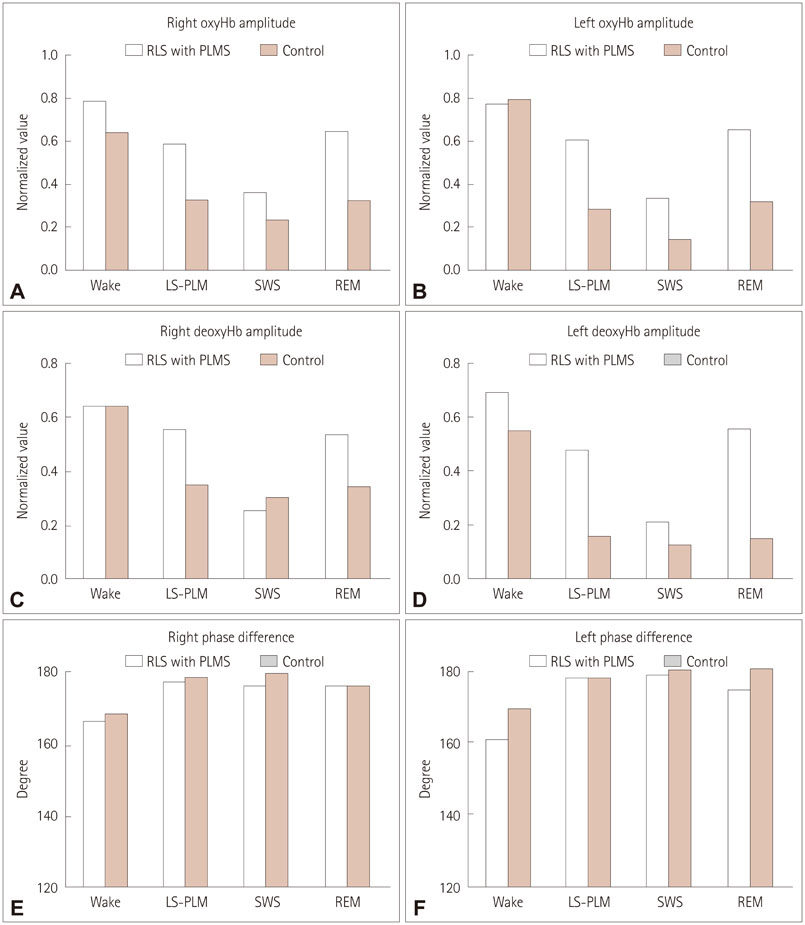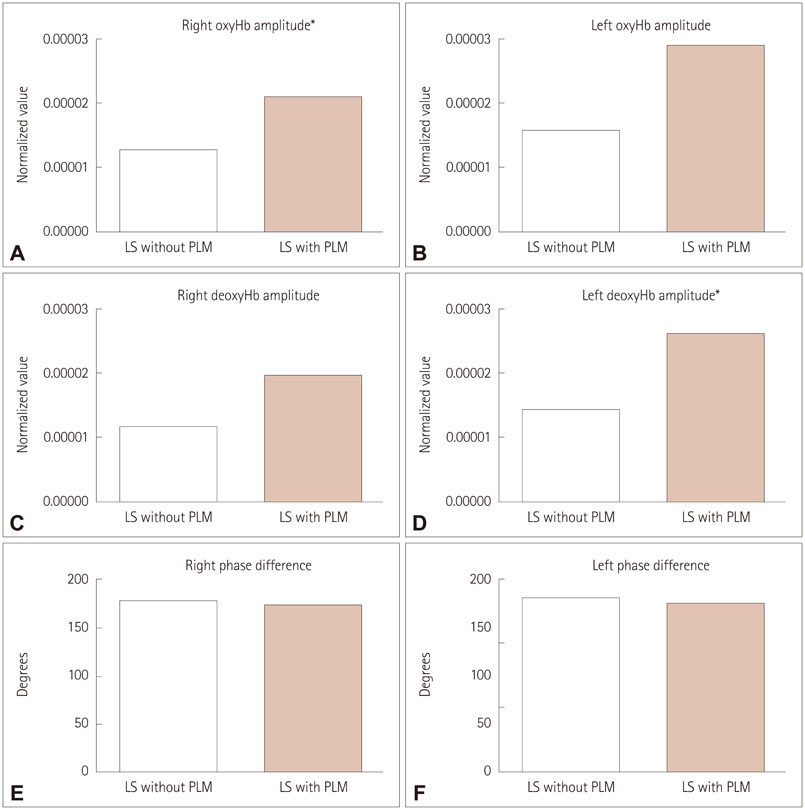J Clin Neurol.
2016 Jan;12(1):107-114. 10.3988/jcn.2016.12.1.107.
Spontaneous Low-Frequency Cerebral Hemodynamics Oscillations in Restless Legs Syndrome with Periodic Limb Movements During Sleep: A Near-Infrared Spectroscopy Study
- Affiliations
-
- 1Department of Neurology, Seoul National University Hospital, Seoul, Korea. jungky10@gmail.com
- 2Neuroscience Research Institute, Seoul National University College of Medicine, Seoul, Korea.
- 3Department of Neurology, College of Medicine, Korea University, Seoul, Korea.
- 4Department of Biomedical Engineering, Korea University, Seoul, Korea. bmk515@korea.ac.kr
- KMID: 2364927
- DOI: http://doi.org/10.3988/jcn.2016.12.1.107
Abstract
- BACKGROUND AND PURPOSE
Periodic limb movements (PLM) during sleep (PLMS) are associated with cortical and cardiovascular activation. Changes in cerebral hemodynamics caused by cortical activity can be measured using near-infrared spectroscopy (NIRS). We investigated oscillatory components of cerebral hemodynamics during PLM and different sleep stages in restless legs syndrome (RLS) patients with PLMS.
METHODS
Four female RLS patients with PLMS, and four age- and sex-matched normal controls were included. PLM and sleep stages were scored using polysomnography, while the spontaneous cerebral hemodynamics was measured by NIRS. The phase and amplitude of the cerebral oxyhemoglobin concentration [HbO] and the deoxyhemoglobin concentration [Hb] low-frequency oscillations (LFOs) were evaluated during each sleep stage [waking, light sleep (LS; stages N1 and N2), slow-wave sleep (stage N3), and rapid eye movement (REM) sleep]. In RLS patients with PLMS, the cerebral hemodynamics during LS was divided into LS with and without PLM.
RESULTS
The cerebral hemodynamics activity varied among the different sleep stages. There were changes in phase differences between [HbO] and [Hb] LFOs during the different sleep stages in the normal controls but not in the RLS patients with PLMS. The [HbO] and [Hb] LFO amplitudes were higher in the patient group than in controls during both LS with PLM and REM sleep.
CONCLUSIONS
The present study has demonstrated the presence of cerebral hemodynamics disturbances in RLS patients with PLMS, which may contribute to an increased risk of cerebrovascular events.
Keyword
MeSH Terms
Figure
Cited by 1 articles
-
Application of near-infrared spectroscopy in clinical neurology
Yoo Hwan Kim, Byung-Jo Kim, Jong Seok Bae
Ann Clin Neurophysiol. 2018;20(2):57-65. doi: 10.14253/acn.2018.20.2.57.
Reference
-
1. Zucconi M, Ferri R, Allen R, Baier PC, Bruni O, Chokroverty S, et al. The official World Association of Sleep Medicine (WASM) standards for recording and scoring periodic leg movements in sleep (PLMS) and wakefulness (PLMW) developed in collaboration with a task force from the International Restless Legs Syndrome Study Group (IRLSSG). Sleep Med. 2006; 7:175–183.
Article2. Koo BB, Blackwell T, Ancoli-Israel S, Stone KL, Stefanick ML, Redline S. Osteoporotic Fractures in Men (MrOS) Study Group. Association of incident cardiovascular disease with periodic limb movements during sleep in older men: outcomes of sleep disorders in older men (MrOS) study. Circulation. 2011; 124:1223–1231.
Article3. Coelho FM, Georgsson H, Narayansingh M, Swartz RH, Murray BJ. Higher prevalence of periodic limb movements of sleep in patients with history of stroke. J Clin Sleep Med. 2010; 6:428–430.
Article4. Walters AS, Rye DB. Review of the relationship of restless legs syndrome and periodic limb movements in sleep to hypertension, heart disease, and stroke. Sleep. 2009; 32:589–597.
Article5. Winkelman JW. The evoked heart rate response to periodic leg movements of sleep. Sleep. 1999; 22:575–580.
Article6. Pennestri MH, Montplaisir J, Colombo R, Lavigne G, Lanfranchi PA. Nocturnal blood pressure changes in patients with restless legs syndrome. Neurology. 2007; 68:1213–1218.
Article7. Espinar-Sierra J, Vela-Bueno A, Luque-Otero M. Periodic leg movements in sleep in essential hypertension. Psychiatry Clin Neurosci. 1997; 51:103–107.
Article8. Haensse D, Szabo P, Brown D, Fauchère JC, Niederer P, Bucher HU, et al. A new multichannel near infrared spectrophotometry system for functional studies of the brain in adults and neonates. Opt Express. 2005; 13:4525–4538.
Article9. Olopade CO, Mensah E, Gupta R, Huo D, Picchietti DL, Gratton E, et al. Noninvasive determination of brain tissue oxygenation during sleep in obstructive sleep apnea: a near-infrared spectroscopic approach. Sleep. 2007; 30:1747–1755.
Article10. Tachtsidis I, Elwell CE, Leung TS, Lee CW, Smith M, Delpy DT. Investigation of cerebral haemodynamics by near-infrared spectroscopy in young healthy volunteers reveals posture-dependent spontaneous oscillations. Physiol Meas. 2004; 25:437–445.
Article11. Mayhew JE, Askew S, Zheng Y, Porrill J, Westby GW, Redgrave P, et al. Cerebral vasomotion: a 0.1-Hz oscillation in reflected light imaging of neural activity. Neuroimage. 1996; 4(3 Pt 1):183–193.
Article12. Katura T, Tanaka N, Obata A, Sato H, Maki A. Quantitative evaluation of interrelations between spontaneous low-frequency oscillations in cerebral hemodynamics and systemic cardiovascular dynamics. Neuroimage. 2006; 31:1592–1600.
Article13. Pierro ML, Sassaroli A, Bergethon PR, Ehrenberg BL, Fantini S. Phase-amplitude investigation of spontaneous low-frequency oscillations of cerebral hemodynamics with near-infrared spectroscopy: a sleep study in human subjects. Neuroimage. 2012; 63:1571–1584.
Article14. Pizza F, Biallas M, Wolf M, Valko PO, Bassetti CL. Periodic leg movements during sleep and cerebral hemodynamic changes detected by NIRS. Clin Neurophysiol. 2009; 120:1329–1334.
Article15. Allen RP, Picchietti D, Hening WA, Trenkwalder C, Walters AS, Montplaisi J, et al. Restless legs syndrome: diagnostic criteria, special considerations, and epidemiology. A report from the restless legs syndrome diagnosis and epidemiology workshop at the National Institutes of Health. Sleep Med. 2003; 4:101–119.
Article16. Cho YW, Lee MY, Yun CH, Shin WC, Hong SB, Kim JH. The reliability and validity of the Korean Version of Paradigm of Questions for Epidemiology Studies of Restless Legs Syndrome and the Johns Hopkins Telephone Diagnostic Interview Form for the Restless Legs Syndrome. J Korean Neurol Assoc. 2007; 25:494–499.17. Walters AS, LeBrocq C, Dhar A, Hening W, Rosen R, Allen RP, et al. Validation of the International Restless Legs Syndrome Study Group rating scale for restless legs syndrome. Sleep Med. 2003; 4:121–132.
Article18. Silber MH, Ancoli-Israel S, Bonnet MH, Chokroverty S, Grigg-Damberger MM, Hirshkowitz M, et al. The visual scoring of sleep in adults. J Clin Sleep Med. 2007; 3:121–131.
Article19. Kim CK, Lee S, Koh D, Kim BM. Development of wireless NIRS system with dynamic removal of motion artifacts. Biomed Eng Lett. 2011; 1:254–259.
Article20. Kocsis L, Herman P, Eke A. The modified Beer-Lambert law revisited. Phys Med Biol. 2006; 51:N91–N98.
Article21. Duncan A, Meek JH, Clemence M, Elwell CE, Tyszczuk L, Cope M, et al. Optical pathlength measurements on adult head, calf and forearm and the head of the newborn infant using phase resolved optical spectroscopy. Phys Med Biol. 1995; 40:295–304.
Article22. Lo MT, Novak V, Peng CK, Liu Y, Hu K. Nonlinear phase interaction between nonstationary signals: a comparison study of methods based on Hilbert-Huang and Fourier transforms. Phys Rev E Stat Nonlin Soft Matter Phys. 2009; 79(6 Pt 1):061924.
Article23. Näsi T, Virtanen J, Noponen T, Toppila J, Salmi T, Ilmoniemi RJ. Spontaneous hemodynamic oscillations during human sleep and sleep stage transitions characterized with near-infrared spectroscopy. PLoS One. 2011; 6:e25415.
Article24. Fantini S, Aggarwal P, Chen K, Franceschini MA, Ehrenberg BL. Near-infrared spectroscopy and polysomnography during all-night sleep in human subjects. In : In : Tuchin VV, editor. Optical Technologies in Biophysics and Medicine IV, 155. Proc. SPIE 5068. Saratov Fall Meeting 2002; 2003 Oct 14; Saratov, Russia. SPIE;2003. DOI: 10.1117/12.518756.25. Madsen PL, Schmidt JF, Wildschiødtz G, Friberg L, Holm S, Vorstrup S, et al. Cerebral O2 metabolism and cerebral blood flow in humans during deep and rapid-eye-movement sleep. J Appl Physiol (1985). 1991; 70:2597–2601.
Article26. Onoe H, Watanabe Y, Tamura M, Hayaishi O. REM sleep-associated hemoglobin oxygenation in the monkey forebrain studied using near-infrared spectrophotometry. Neurosci Lett. 1991; 129:209–213.
Article27. Schober T, Wenzel K, Feichtinger M, Schwingenschuh P, Strebel A, Krausz G, et al. Restless legs syndrome: changes of induced electroencephalographic beta oscillations-an ERD/ERS study. Sleep. 2004; 27:147–150.
Article28. Bucher SF, Seelos KC, Oertel WH, Reiser M, Trenkwalder C. Cerebral generators involved in the pathogenesis of the restless legs syndrome. Ann Neurol. 1997; 41:639–645.
Article29. Astrakas LG, Konitsiotis S, Margariti P, Tsouli S, Tzarouhi L, Argyropoulou MI. T2 relaxometry and fMRI of the brain in late-onset restless legs syndrome. Neurology. 2008; 71:911–916.
Article30. Trinder J, Kleiman J, Carrington M, Smith S, Breen S, Tan N, et al. Autonomic activity during human sleep as a function of time and sleep stage. J Sleep Res. 2001; 10:253–264.
Article
- Full Text Links
- Actions
-
Cited
- CITED
-
- Close
- Share
- Similar articles
-
- The Clinical Significance of Periodic Limb Movements During Sleep in Various Sleep Disorders
- Parasomnias in the Elderly
- Periodic Limb Movement and Restless legs Syndrome in Neurological Disorders
- Diagnosis and Treatment of Restless Leg Syndrome and Periodic Limb Movement of Sleep
- The Pathophysiology of Restless Legs Syndrome/Willis-Ekbom Disease



